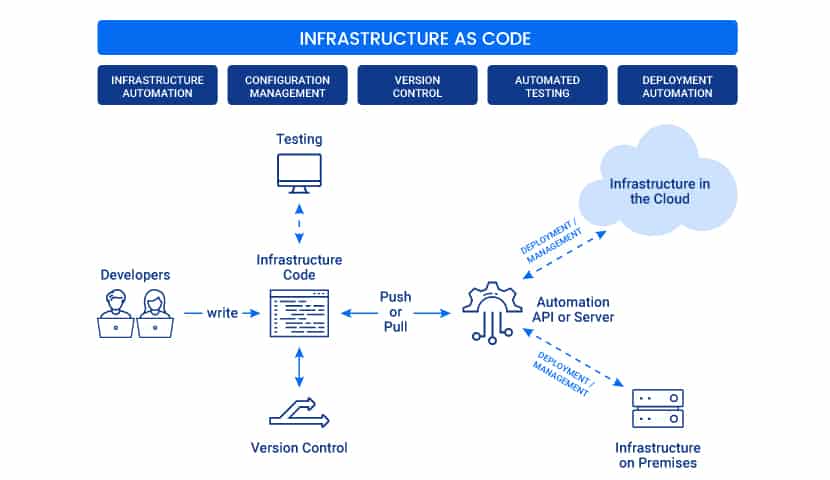What Is Infrastructure as Code? Benefits, Best Practices, & Tools
Infrastructure as Code (IaC) enables developers to provision IT environments with several lines of code. Unlike manual infrastructure setups that require hours or even days to configure, it takes minutes to deploy an IaC system.
This article explains the concepts behind Infrastructure as Code. You will learn how IaC works and how automatic configurations enable teams to develop software with higher speed and reduced cost.
What is Infrastructure as Code (IaC)?
Infrastructure as Code is the process of provisioning and configuring an environment through code instead of manually setting up the required devices and systems. Once code parameters are defined, developers run scripts, and the IaC platform builds the cloud infrastructure automatically.
Such automatic IT setups enable teams to quickly create the desired cloud setting to test and run their software. Infrastructure as Code allows developers to generate any infrastructure component they need, including networks, load balancers, databases, virtual machines, and connection types.
How Infrastructure as Code WorkS
Here is a step-by-step explanation of how creating an IaC environment works:
- A developer defines the configuration parameters in a domain-specific language (DCL).
- The instruction files are sent to a master server, a management API, or a code repository.
- The IaC platform follows the developer’s instructions to create and configure the infrastructure.
With IaC, users don’t need to configure an environment every time they want to develop, test, or deploy software. All infrastructure parameters are saved in the form of files called manifests.
As all code files, manifests are easy to reuse, edit, copy, and share. Manifests make building, testing, staging, and deploying infrastructure quicker and consistent.
Developers codify the configuration files store them in version control. If someone edits a file, pull requests and code review workflows can check the correctness of the changes.

What Issues Does Infrastructure as Code Solve?
Infrastructure as Code solves the three main issues of manual setups:
- High price
- Slow installs
- Environment inconsistencies
High Price
Manually setting up each IT environment is expensive. You need dedicated engineers for setting up the hardware and software. Network and hardware technicians require supervisors, so there is more management overhead.
With Infrastructure as Code, a centrally managed tool sets up an environment. You pay only for the resources you consume, and you can quickly scale up and down your resources.
Slow Installs
To manually set up an infrastructure, engineers first need to rack the servers. They then manually configure the hardware and network to the desired settings. Only then can engineers start to meet the requirements of the operating system and the hosted application.
This process is time-consuming and prone to mistakes. IaC reduces the setup time to minutes and automates the process.
Environment Inconsistencies
Whenever several people are manually deploying configurations, inconsistencies are bound to occur. Over time, it gets difficult to track and reproduce the same environments. These inconsistencies lead to critical differences between development, QA, and production environments. Ultimately, the differences in settings inevitably cause deployment issues.
Infrastructure as Code ensures continuity as environments are provisioned and configured automatically with no room for human error.
The Role of Infrastructure as Code in DevOps
Infrastructure as Code is essential to DevOps. Agile processes and automation are possible only if there is a readily available IT infrastructure to run and test the code.
With IaC, DevOps teams enjoy better testing, shorter recovery times, and more predictable deployments. These factors are vital for quick-paced software delivery. Uniform IT environments lower the chances of bugs arising in the DevOps pipeline.
The IaC approach has no limitations as DevOps teams provision all aspects of the needed infrastructure. Engineers create servers, deploy operating systems, containers, application configurations, set up data storage, networks, and component integrations.
IaC can also be integrated with CI/CD tools. With the right setup, the code can automatically move app versions from one environment to another for testing purposes.

Learn why businesses are increasingly turning to DevOps in our article Infrastructure in the Age of DevOps.
Benefits of Infrastructure as Code
Here are the benefits an organization gets from Infrastructure as Code:
Speed
With IaC, teams quickly provision and configure infrastructure for development, testing, and production. Quick setups speed up the entire software development lifecycle.
The response rate to customer feedback is also faster. Developers add new features quickly without needing to wait for more resources. Quick turnarounds to user requests improve customer satisfaction.
Standardization
Developers get to rely on system uniformity during the delivery process. There are no configuration drifts, a situation in which different servers develop unique settings due to frequent manual updates. Drifts lead to issues at deployment and security concerns.
IaC prevents configuration drifts by provisioning the same environment every time you run the same manifest.
Reusability
DevOps teams can reuse existing IaC scripts in various environments. There is no need to start from scratch every time you need new infrastructure.
Collaboration
Version control allows multiple people to collaborate on the same environment. Thanks to version control, developers work on different infrastructure sections and roll out changes in a controlled manner.
Efficiency
Infrastructure as Code improves efficiency and productivity across the development lifecycle.
Programmers create sandbox environments to develop in isolation. Operations can quickly provision infrastructure for security tests. QA engineers have perfect copies of the production environments during testing. When it is deployment time, developers push both infrastructure and code to production in one step.
IaC also keeps track of all environment build-up commands in a repository. You can quickly go back to a previous instance or redeploy an environment if you run into a problem.
Lower Cost
IaC reduces the costs of developing software. There is no need to spend resources on setting up environments manually.
Most IaC platforms offer a consumption-based cost structure. You only pay for the resources you are actively using, so there is no unnecessary overhead.
Scalability
IaC makes it easy to add resources to existing infrastructure. Upgrades are provisioned quickly, and with ease, so you can quickly expand during burst periods.
For example, organizations running online services can easily scale up to keep up with user demands.
Disaster Recovery
In the event of a disaster, it is easy to recover large systems quickly with IaC. You just re-run the same manifest, and the system will be back online at a different location if need be.

Infrastructure as Code Best Practices
Use Little to No Documentation
Define specifications and parameters in configuration files. There is no need for additional documentation that gets out of sync with the configurations in use.
Version Control All Configuration Files
Place all your configuration files under source control. Versioning gives flexibility and transparency when managing infrastructure. It also allows you to track, manage, and restore previous manifests.
Constantly Test the Configurations
Test and monitor environments before pushing any changes to production. To save time, consider setting up automated tests to run whenever the configuration code gets modified.
Go Modular
Divide your infrastructure into multiple components and then combine them through automation. IaC segmentation offers many advantages. You control who has access to certain parts of your code. You also limit the number of changes that can be made to manifests.
Infrastructure as Code Tools
IaC tools speed up and automate the provisioning of cloud environments. Most tools also monitor previously created systems and roll back changes to the code.
While they vary in terms of features, there are two main types of Infrastructure as Code tools:
- Imperative tools
- Declarative tools
Imperative Approach Tools
Tools with an imperative approach define commands to enable the infrastructure to reach the desired state. Engineers create scripts that provision the infrastructure one step at a time. It is up to the user to determine the optimal deployment process.
The imperative approach is also known as the procedural approach.
When compared to declarative approach tools, imperative IaC requires more manual work. More tasks are required to keep scripts up to date.
Imperative tools are a better fit with system admins who have a background in scripting.
const aws = require("@pulumi/aws");
let size = "t2.micro";
let ami = "ami-0ff8a91507f77f867"
let group = new aws.ec2.SecurityGroup("webserver-secgrp", {
ingress: [
{protocol: "tcp", fromPort: 22, toPort: 22, cidrBlocks: ["0.0.0.0/0"] },
],
});
let server = new aws.ec2.Instance("webserver-www", {
instanceType: size,
securityGroups: [ group.name ],
ami: ami,
});
exports.publicIp = server.publicIp;
exports.publicHostName= server.publicDns;Imperative IaC example (using Pulumi)
Declarative Approach Tools
A declarative approach describes the desired state of the infrastructure without listing the steps to reach that state. The IaC tool processes the requirements and then automatically configures the necessary software.
While no step-by-step instruction is needed, the declarative approach requires a skilled administrator to set up and manage the environment.
Declarative tools are catered towards users with strong programming experience.
resource "aws_instance" "myEC2" {
ami = "ami-0ff8a91507f77f867"
instance_type = "t2.micro"
security_groups = ["sg-1234567"]
}Declarative Infrastructure as Code example (using Terraform)
Popular IaC Tools
The most widely used Infrastructure as Code tools on the market include:
- Terraform: This open-source declarative tool offers pre-written modules that you populate with parameters to build and manage an infrastructure.
- Pulumi: The main advantage of Pulumi is that users can rely on their favorite language to describe the desired infrastructure.
- Puppet: Using Puppet’s Ruby-based DSL, you define the desired state of the infrastructure, and the tool automatically creates the environment.
- Ansible: Ansible enables you to model the infrastructure by describing how the components and systems relate to one another.
- Chef: Chef is the most popular imperative tool on the market. Chef allows users to make “recipes” and “cookbooks” using its Ruby-based DSL. These files specify the exact steps needed to achieve the desired environment.
- SaltStack: What sets SaltStack apart is the simplicity of provisioning and configuring infrastructure components.
Learn more about Pulumi in our article What is Pulumi?
To see how different options tools stack up, read Terraform vs. Puppet and SaltStack vs. Ansible.
Want to Stay Competitive, IaC is Not Optional
Infrastructure as Code is an effective way to keep up with the rapid pace of current software development. In a time when IT environments must be built, changed, and torn down daily, IaC is a requirement for any team wishing to stay competitive.
PhoenixNAP’s Bare Metal Cloud platform supports API driven provisioning of servers. It’s also fully integrated with Ansible and Terraform, two of the leading Infrastructure as Code tools.
Learn more about Bare Metal Cloud and how it can help propel an organization’s Infrastructure as Code efforts.
Leave a Reply
You must be logged in to post a comment.